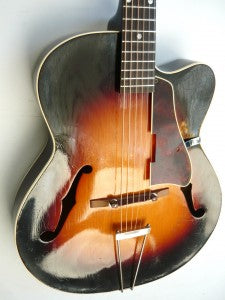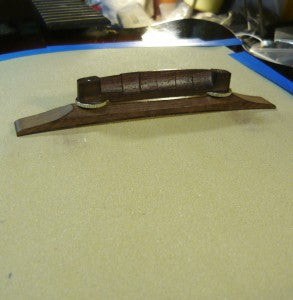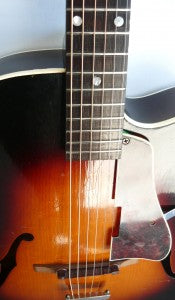Here's an old gem that came in for some serious love. It was in generally good overall condition but wasn't playing anywhere near it potential. After a bit of TLC it came up surprisingly well and plays and sounds like a great old archtop acoustic.
The bridge on it was a mess. Someone had gone to town on trying to shave it down in all directions to get the action down but had damaged it beyond repair so a new bridge was in order.
The frets were very badly worn in the open position chords as well and it was touch and go as to weather it was going to need a re-fret. If it was going to be a well played and recording guitar, I probably would have done one, but since it was a "family heirloom" type guitar that the son of the original owner wanted to get it playing nicely so he could strum it, I thought the least amount of impact (and cost) would be best.
Because no two archtops are the same carve, generic bridges are "averaged" out with the curve on the bottom which is what makes contact with the top of the guitar. While this fit doesn't have to be "machine quality" fit, you do want it very close to the top of the guitar you're fitting it to.
The easiest way to do this is ...........
Tape a piece of sandpaper carefully to the top of the guitar where the bridge goes with low tack tape and simple sand the bottom of the bridge. This gives you the perfect curve on the bottom of the bridge.
With the bridge done it was time to turn to those frets. They were very worn but they weren't small to start with. Not jumbos by any means, but they were "big" Fender style frets so I had something to work with.
As I've said before, I'd rather salvage original frets than do a re-fret for no reason (or to make money) as even a good re-fret can change the way a guitar sounds and plays.
This dress went well with me doing about three complete dresses to get it to a satisfactory playing condition. Well worth the effort.
The owner had the original truss rod cover at home but the rod needed a tweak anyway, and the neck came up great, especially for a guitar like this at it's age.
The frets were good, the bridge was done and it was time for a good set up and get this thing playing like it never has before.
I left some depth on the bridge string slots as this guitar didn't have a lot of break angle after the bridge to the tailpiece and if you were strumming hard, as you can on an old acoustic, the strings could jump out of the slots.
I still had plenty of downward pressure on the bridge so it didn't move and plenty of depth in those slots.


















